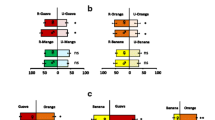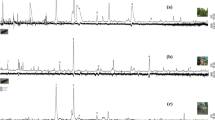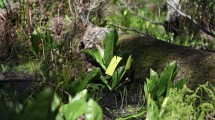Abstract
Drosophila suzukii (Diptera: Drosophilidae) is native to Southeast Asia and now has become a severe pest of several soft fruits in Europe and the Americas. It causes considerable damage to Chinese bayberry, Myrica rubra, in China. In the present study, we employed gas chromatograph–electroantennographic detection (GC–EAD) together with behavioural bioassays and trapping experiments to identify volatile semiochemicals emitted by Chinese bayberry attracting D. suzukii. Electrophysiological experiments revealed the presence of six EAD-active compounds from ripe bayberry fruits, including methyl (E)-3-hexenoate, methyl (E)-2-hexenoate, ethyl (E)-2-hexenoate, α-ylangene, α-humulene and an unidentified compound that elicited consistent antennal response. In two-choice bioassays, bayberry fruits attracted all responding flies, and significantly more flies responded to the volatile extract of bayberry fruits. Four EAD-active compounds were attractive to mated female D. suzukii at lower doses (0.01 and 0.1 µg), but showed repellency at higher doses (10 and 100 µg). Mixtures of these four compounds at different ratios attracted D. suzukii flies at all test doses (0.1, 1 and 10 µg). Both male and female flies were trapped by a mixture of synthetic methyl (E)-3-hexenoate, methyl (E)-2-hexenoate, ethyl (E)-2-hexenoate and α-humulene in a ratio of 1:1.3:1:6.4 in the field trapping experiment. Significantly more males than females were captured in the trap baited with the synthetic blend, and the percentages of D. suzukii captured out of all flies by the traps baited with lure were higher than that baited with blank control. Our findings may provide insights into the olfactory responses of D. suzukii to specific host plant volatiles, and contribute to further development of an effective lure for monitoring D. suzukii in the field.



Similar content being viewed by others
References
Abraham J, Zhang A, Angeli S, Abubeker S, Michel C, Feng Y, Rodriguezsaona C (2015) Behavioral and antennal responses of Drosophila suzukii (Diptera: Drosophilidae) to volatiles from fruit extracts. Environ Entomol 44:356–367
Allada R, Chung BY (2010) Circadian organization of behavior and physiology in Drosophila. Ann Rev Physiol 72:605–624
Asplen MK, Anfora G, Biondi A et al (2015) Invasion biology of spotted wing Drosophila (Drosophila suzukii): a global perspective and future priorities. J Pest Sci 88:469–494
Avanesyan A, Jaffe BD, Guedot C (2017) Isolating spermathecae and determining mating status of Drosophila suzukii: a protocol for tissue dissection and its applications. Insects 8:32
Bruce TJ, Pickett JA (2011) Perception of plant volatile blends by herbivorous insects finding the right mix. Phytochemistry 72:1605–1611
Bruce TJ, Wadhams LJ, Woodcock CM (2005) Insect host location: a volatile situation. Trends Plant Sci 6:269–274
Calabria G, Máca J, Bächli G, Serra L, Pascual M (2012) First records of the potential pest species Drosophila suzukii (Diptera: Drosophilidae) in Europe. J Appl Entomol 136:139–147
Carlos JMC, José RCV, Osorio C, Jimenez AM (2011) Volatile compounds during the ripening of colombian soursop (Annona muricata L. cv. Elita). Vitae 18:245–250
Cha DH, Adams T, Rogg H, Landolt PJ (2012) Identification and field evaluation of fermentation volatiles from wine and vinegar that mediate attraction of spotted wing drosophila, Drosophila suzukii. J Chem Ecol 38:1419–1431
Cha DH, Hesler SP, Cowles RS, Vogt H, Loeb GM, Landolt PJ (2013) Comparison of a synthetic chemical lure and standard fermented baits for trapping Drosophila suzukii (Diptera: Drosophilidae). Environ Entomol 42:1052–1060
Cha DH, Adams T, Werle CT, Sampson BJ, Adamczyk JJ Jr, Rogg H, Landolt PJ (2014) A four-component synthetic attractant for Drosophila suzukii (Diptera: Drosophilidae) isolated from fermented bait headspace. Pest Manag Sci 70:324–331
Chen L, Sharma KR, Fadamiro HY (2009) Fire ant venom alkaloids act as key attractants for the parasitic phorid fly, Pseudacteon tricuspis (Diptera: Phoridae). Naturwissenschaften 96:1421–1429
Cheng J, Ye X, Chen J, Liu D, Zhou S (2008) Nutritional composition of underutilized bayberry (Myrica rubra Sieb. et Zucc.) kernels. Food Chem 107:1674–1680
Cheng H, Chen J, Chen S, Wu D, Liu D, Ye X (2015a) Characterization of aroma-active volatiles in three Chinese bayberry (Myrica rubra) cultivars using GC-MS-olfactometry and an electronic nose combined with principal component analysis. Food Res Int 72:8–15
Cheng H, Chen J, Li X, Pan J, Xue SJ, Liu D, Ye X (2015b) Differentiation of the volatile profiles of Chinese bayberry cultivars during storage by HS-SPME-GC/MS combined with principal component analysis. Postharvest Bio Tec 100:59–72
Cheng H, Chen J, Chen S, Xia Q, Liu D, Ye X (2016) Sensory evaluation, physicochemical properties and aroma-active profiles in a diverse collection of Chinese bayberry (Myrica rubra) cultivars. Food Chem 212:374–385
Cini A, Ioriatti C, Anfora G (2012) A review of the invasion of Drosophila suzukii in Europe and a draft research agenda for integrated pest management. Bull Insectol 65:149–160
Clavijo Mccormick A, Gershenzon J, Unsicker SB (2014) Little peaks with big effects: establishing the role of minor plant volatiles in plant-insect interactions. Plant Cell Environ 37:1836–1844
da Silva EAJ, da Silva VP, Alves CCF, Alves JM, Souchie EL, Barbosa LCD (2016) Harvest time on the content and chemical composition of essential oil from leaves of guava. Cienc Rural 46:1771–1776
Damiani C, de Barros Vilas Boas EV, Ferri PH, Pinto DM, Rodrigues LJ (2009) Volatile compounds profile of fresh-cut peki fruit stored under different temperatures. Ciencia Tecnol Aliment 29:435–439
de Santana KL, Galvao MdS, de Jesus MS, Nogueira JP, Narain N (2017) HS-SPME optimization and extraction of volatile compounds from soursop (Annona muricata L.) pulp with emphasis on their characteristic impact compounds. Food Sci Technol 37:250–260
Dubruille R, Emery P (2008) A plastic clock: how circadian rhythms respond to environmental cues in Drosophila. Mol Neurobiol 38:129–145
Goodhue RE, Bolda M, Farnsworth D, Williams JC, Zalom FG (2011) Spotted wing drosophila infestation of California strawberries and raspberries: economic analysis of potential revenue losses and control costs. Pest Manage Sci 67:1396–1402
Hammack L (2003) Volatile semiochemical impact on trapping and distribution in maize of northern and western corn rootworm beetles (Coleoptera: Chrysomelidae). Agric For Entomol 5:113–122
Kang W, Li Y, Xu Y, Jiang W, Tao Y (2012) Characterization of aroma compounds in Chinese bayberry (Myrica rubra Sieb. et Zucc.) by Gas Chromatography Mass Spectrometry (GC-MS) and Olfactometry (GC-O). J Food Sci 77:C1030-C1035
Keesey IW, Knaden M, Hansson BS (2015) Olfactory specialization in Drosophila suzukii supports an ecological shift in host preference from rotten to fresh fruit. J Chem Ecol 41:121–128
Kenis M, Tonina L, Eschen R et al (2016) Non-crop plants used as hosts by Drosophila suzukii in Europe. J Pest Sci 89:735–748
Kim YJ, Lee YG, Choi YW, Kim YC (2008) Effects of drying conditions on the profile of volatile terpenoid and colour of schizandra fruit (Schizandra chinensis fructus). J Life Sci 18:1066–1071
Kleiber JR, Unelius CR, Lee JC, Suckling DM, Qian MC, Bruck DJ (2014) Attractiveness of fermentation and related products to spotted wing drosophila (Diptera: Drosophilidae). Environ Entomol 43:439–447
Knolhoff LM, Heckel DG (2014) Behavioral assays for studies of host plant choices and adaptation in herbivorous insects. Annu Rev Entomol 59:263–278
Kouloussis NA, Katsoyannos BI, Papadopoulos NT, Ioannou CS, Iliadis IV (2013) Enhanced mating competitiveness of Ceratitis capitata males following exposure to citrus compounds. J Appl Entomol 137:30–38
Lee JC, Bruck DJ, Dreves AJ, Ioriatti C, Vogt H, Baufeld P (2011) In focus: spotted wing drosophila, Drosophila suzukii, across perspectives. Pest Manag Sci 67:1349–1351
Lee JC, Burrack HJ, Barrantes LD et al (2012) Evaluation of monitoring traps for Drosophila suzukii (Diptera: Drosophilidae) in North America. J Econ Entomol 105:1350–1357
Lemos M, Santin JR, Mizuno CS et al (2015) Copaifera langsdorffii: evaluation of potential gastroprotective of extract and isolated compounds obtained from leaves. Rev Bras Farmacogn-Braz J Pharmacogn 25:238–245
Li T, Blande JD, Holopainen JK (2016) Atmospheric transformation of plant volatiles disrupts host plant finding. Sci Rep 6:33851
Liu XF, Chen HH, Li JK, Zhang R, Turlings TC, Chen L (2016) Volatiles released by Chinese liquorice roots mediate host location behaviour by neonate Porphyrophora sophorae (Hemiptera: Margarodidae). Pest Manag Sci 72:1959–1964
Liu Y, Xie DS, Zhang F et al (2017) Oviposition preferences and reproductive success of Drosophila suzukii on 4 non-host fruits. Chin J Appl Entomol 54:107–112
Mariscal-Lucero SDR, Rosales-Castro M, Sanchez-Monsalvo V, Honorato-Salazar JA (2015) Evaluation of phenols and limonoids in leaves of Cedrela odorata (Meliaceae) from an experimental plantation established in Tezonapa Veracruz, Mexico. Rev Biol Trop 63:545–558
Mitsui H, Takahashi KH, Kimura MT (2006) Spatial distributions and clutch sizes of Drosophila species ovipositing on cherry fruits of different stages. Popul Ecol 48:233–237
Niogret J, Montgomery WS, Kendra PE, Heath RR, Epsky ND (2011) Attraction and electroantennogram responses of male Mediterranean fruit fly to volatile chemicals from Persea, Litchi and Ficus wood. J Chem Ecol 37:483–491
Revadi S, Eccher F, Mazzoni V et al (2015) Olfactory responses of Drosophila suzukii females to host plant volatiles. Physiol Entomol 40:54–64
Rossi-Stacconi MV, Kaur R, Mazzoni V et al (2016) Multiple lines of evidence for reproductive winter diapause in the invasive pest Drosophila suzukii: useful clues for control strategies. J Pest Sci 89:689–700
Semmelhack JL, Wang JW (2009) Select Drosophila glomeruli mediate innate olfactory attraction and aversion. Nature 459:218–223
Siderhurst MS, Jang EB (2006) Female-biased attraction of oriental fruit fly, Bactrocera dorsalis (Hendel), to a blend of host fruit volatiles from Terminalia catappa L. J Chem Ecol 32:2513–2524
Soares FD, Pereira T, Mom M, Monteiro AR (2007) Volatile and non-volatile chemical composition of the white guava fruit (Psidium guajava) at different stages of maturity. Food Chem 100:15–21
Stensmyr MC, Giordano E, Balloi A, Angioy AM, Hansson BS (2003) Novel natural ligands for Drosophila olfactory receptor neurons. J Exp Biol 206:715–724
Sun XL, Wang GC, Gao Y, Zhang XZ, Xin ZJ, Chen ZM (2014) Volatiles emitted from tea plants infested by Ectropis obliqua larvae are attractive to conspecific moths. J Chem Ecol 40:1080–1089
Wallingford AK, Hesler SP, Cha DH, Loeb GM (2016) Behavioral response of spotted-wing drosophila, Drosophila suzukii Matsumura, to aversive odors and a potential oviposition deterrent in the field. Pest Manag Sci 72:701–706
Walsh DB, Bolda MP, Goodhue RE et al (2011) Drosophila suzukii (Diptera: Drosophilidae): invasive pest of ripening soft fruit expanding its geographic range and damage potential. J Integr Pest Manag 2:G1-G7
Wijk MV, Bruijn PJAD., Sabelis MW (2011) Complex odor from plants under attack: herbivore’s enemies react to the whole, not its parts. PLoS ONE 6:e21742
Wu SR, Tai HK, Li ZY, Wang X, Yang SS, Sun W, Xiao C (2007) Field evaluation of different trapping methods of cherry fruit fly, Drosophila suzukii. J Yunnan Agric Univ 22:776–782
Zhao C, Li P, Xie D et al (2017) The seasonal abundance of Drosophila suzukii in orchards and seasonal variation in fruit damage caused by this pest. Chin J Appl Entomol 54:724–729
Zheng J, Zhang T, Xu Y, Wang G, Tang P, Fu L, Lu T (2015) Distribution of Drosophilid flies on Chinese bayberry fruits at different stages of maturity. Chin J Appl Entomol 52:470–476
Acknowledgements
This research was supported through funding from the European Union’s Seventh Framework programme for research, technological development and demonstration under grant agreement number 613678 (DROPSA).
Author information
Authors and Affiliations
Corresponding authors
Additional information
Handling Editor: Jarmo Holopainen.
Yan Liu and Wenxia Dong contributed equally to this work.
Rights and permissions
About this article
Cite this article
Liu, Y., Dong, W., Zhang, F. et al. Identification of active components from volatiles of Chinese bayberry, Myrica rubra attractive to Drosophila suzukii. Arthropod-Plant Interactions 12, 435–442 (2018). https://doi.org/10.1007/s11829-018-9595-z
Received:
Accepted:
Published:
Issue Date:
DOI: https://doi.org/10.1007/s11829-018-9595-z




